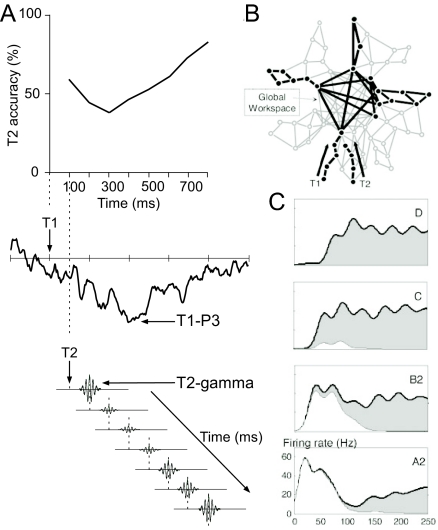Figure 2.
(a) Illustration of the model proposed by Fell, Klaver, Elger, and Fernandez (2002). According to this model the P3 that is evoked by the presentation of T1 and peaks around 400 ms after T1 impairs the early evoked gamma response for T2. The gamma response is assumed to be necessary for selection and identification of target stimuli and its impairment causes the attentional blink (AB).
(b) Illustration of the application of the neuronal workspace model of conscious access to the AB as suggested by Dehaene, Sergent, and Changeux (2003). The schematic architecture of brain areas comprises multiple specialized processors and a central network of high-level areas temporarily interconnecting them. It is assumed that in the AB, T1 invades this “neuronal workspace” and areas lock into a single assembly supporting conscious reportability of T1. The invasion of the workspace by T1 blocks the processing of T2 at a similar depth thus causing the failure to report T2.
(c) Neural activity evoked by seen and unseen T2 targets in recordings simulating the neuronal workspace model of conscious access. A2 and B2 refer to perceptual areas processing T2, C and D refer to higher association areas. In trials in which T2-related activity is evident in area D (T2 seen trials), simulated activity in lower areas C, B2, and A2 is characterized by long-lasting amplification (activity of area D and the resulting amplification are indicated in grey). If area D remains inactive, activity is short and mainly restricted to perceptual areas B2 and A2 (indicated in white). Sections (b) and (c) adapted from “A Neuronal Network Model Linking Subjective Reports and Objective Physiological Data During Conscious Perception” by S. Dehaene, C. Sergent, and J. P. Changeux, 2003), Proceedings of the National Academy of Sciences of the United States of America, 100(14), pp. 8521, 8524. Copyright 2003 by the National Academy of Sciences, U.S.A.

